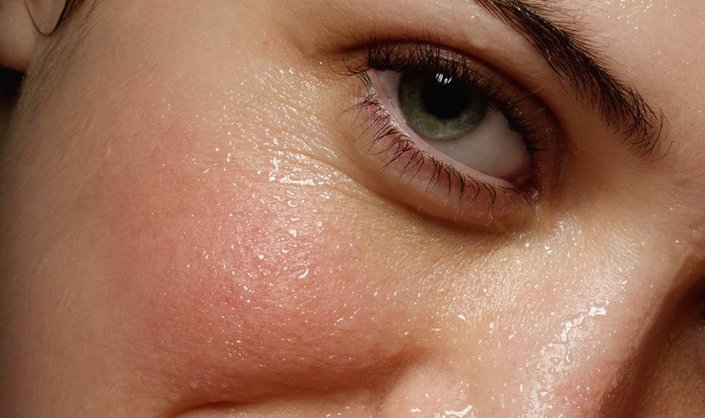Your Burning Rosacea Questions, Answered
October 24, 2022
Dealing with rosacea? You probably have some unanswered questions — and we’re here to help! We tapped New York-based dermatologist, and Skincare.com consultant, Dr. Joshua Zeichner, for help answering some of the most frequently asked questions about rosacea. From common triggers to how to help prevent flare-ups, consider this your ultimate guide to rosacea.
What Is Rosacea?
Rosacea (pronounced rose-AY-sha) is a very common chronic skin condition. In fact, the National Rosacea Society (NRS) reports that 16 million Americans have rosacea, yet only a small percentage are actively addressing side effects. And just what can those side effects look like? According to Dr. Zeichner, rosacea is characterized by “easy flushing, along with red bumps or pus pimples in the middle to 1/3 of the face.” That flushing, or redness, typically appears after age 30 on the cheeks, nose, forehead and chin, though it’s not limited to these areas.
What Causes Rosacea?
The cause of rosacea is currently unknown, but experts think it could be due to a combination of hereditary and environmental factors. “Anything that makes the face flush can lead to a rosacea flare,” says Dr. Zeichner. “This can include extremes in temperature, spicy foods, alcohol, hot beverages and emotional stress.” The Mayo Clinic lists additional factors such as sunlight or wind, emotions, exercise and even some cosmetics. “Those dealing with rosacea have skin that’s sensitive to the environment and hyper-reactive to triggers that should typically not upset the skin in such a way,” Dr. Zeichner says.
What Are Common Symptoms of Rosacea?
Think you may be experiencing symptoms of rosacea? If you’re dealing with at least two of the symptoms listed below, it very well could be, according to the NRS:
Flushing
The most common symptom of rosacea is persistent facial redness that looks like a sunburn that won’t go away. This type of facial redness is often accompanied by heat, warmth or a burning sensation that can come and go.
Bumps and pimples
Small red bumps and pus-filled pimples may surface on rosacea-prone skin. These blemishes should not be confused with acne, as blackheads are absent and these bumps and pimples can often sting.
Visible blood vessels
Many people with rosacea experience visible small blood vessels on the cheeks, nose and other areas located centrally on the face.
Eye irritation
Red and swollen eyelids may occur. Crust and scale accumulation around the eyelids are a common symptom as well.
These symptoms can come and go in a series of rosacea flare-ups and remissions. Due to its similarities in appearance to acne, many people mistake rosacea for acne or an allergic reaction. When in doubt, talk to your dermatologist about your symptoms for a proper diagnosis.
How Can You Help Address Rosacea?
“We address rosacea symptoms with products that help repair the skin barrier and reduce inflammation,” says Dr. Zeichner. “Good moisturizers and gentle cleansers that keep the skin barrier in good shape are key components to effectively addressing rosacea.” That said, scan all product labels prior to purchase and use. When shopping for products, you’ll want to avoid ingredients that can potentially irritate your skin further. Steer clear of skincare products formulated with alcohol, camphor, fragrance, glycolic acid, lactic acid, menthol, and/or sodium laurel sulfate just to name a few.
When in doubt, consult with your dermatologist for a personalized regimen. “Depending on the severity of your rosacea, your dermatologist can prescribe you anti-inflammatory topical medications if necessary,” says Dr. Zeichner.
How Can You Help Prevent Rosacea Flare-Ups?
While it’s uncertain as to what specifically causes rosacea, there are some lifestyle practices you can adopt to help reduce your chances of flare-ups.
Be Wary of UV Exposure
According to the American Academy of Dermatology (AAD), a few minutes of sunlight on rosacea-prone skin can increase the likelihood of getting addition flushness and redness. Where possible, avoid direct sun exposure on afflicted areas. Prior to heading outdoors, apply broad-spectrum sunscreen to all exposed areas of the skin and reapply at least every two hours. Provide additional protection with protective clothing, such as hats and long sleeves, seeking shade, and avoiding peak sun hours—between 10 a.m. and 4 p.m.—when rays are strongest.
Reduce Stress
Stress comes in a close second after sun exposure on NRS’ list of common rosacea triggers. To provide further confirmation, the AAD notes that stress can oftentimes worsen symptoms of rosacea. Find ways to eliminate or cope with your stress! This can include enjoying an aromatherapy bath, getting some rest, or curling up with a good book.
Avoid Hot Beverages
Research indicates that the heat from hot beverages can trigger flares in rosacea. Try swapping your steamy drink of choice for an iced version instead.
Drink Alcohol in Moderation
A study published in the Journal of the American Academy of Dermatology found that the risk of developing rosacea increased with the amount of alcohol drank. However, more studies are required to determine whether drinking can cause rosacea, and what types of drinks in particular — and in what quantity — can increase that risk.
What Does a Rosacea-Friendly Skincare Regimen Look Like?
As Dr. Zeichner mentioned, the right skincare regimen can make all the difference in the world when it comes to addressing rosacea. Not only can it help your skin feel more comfortable, but it can even boost your skin’s overall health and reduce flare-ups.
Step #1: Cleanse Your Skin Twice a Day.
According to the AAD, those with rosacea often don’t wash their skin enough. Get in the habit of cleansing with a mild cleanser (not bar soap!) morning and night. For optimal results, massage the cleanser gently using circular motions and rinse thoroughly with lukewarm water. Any lingering product may cause further irritation, so take your time with it.
Step #2: Apply a Gentle Moisturizer.
Regardless of skin type, those with rosacea-prone skin can’t neglect moisturizer from their routine. Moisturizing is the most efficient way to keeping your skin well-hydrated, and studies have shown that doing so can not only improve the results you see from any treatment you may be using, but also reduce your skin’s overall irritation.
Step #3: Apply a Non-Irritating Sunscreen.
Protecting your skin day in and day out with sunscreen is one of the most important things you can do for your skin. Unfortunately, some sunscreens don’t keep rosacea-prone skin types in mind, so you’ll have to be picky. Look for keywords such as zinc oxide, titanium oxide, silicone, fragrance-free, and broad-spectrum protection with SPF 30 or higher plastered on the label.
Can I Apply Makeup to Rosacea?
You can certainly apply makeup to rosacea-prone skin, but select your cosmetics carefully. If makeup seems to be the likely culprit for your flare ups, consider tossing them for gentler counterparts. Aim for light, liquid-based formulas that spread easily.
Editor’s tip: Rosacea can bring out unsightly redness that may not be fully concealed by light makeup. Consider investing in green-tinted primers to counteract those signs of redness prior to applying your foundation or concealer. And as an added bonus, it can help your makeup stay on longer.
Is Rosacea Contagious?
No, rosacea is not contagious. According to the NRS, there is no evidence that shows that rosacea has the ability to spread through skin-to-skin contact or through inhaling airborne bacteria.
Can Rosacea Get Worse With Age?
Currently, there aren’t enough studies that show a direct correlation between rosacea and aging. However, rosacea left unaddressed can become increasingly severe. In an NRS survey, research showed that about half of those who suffered from rosacea found that — without treatment — their condition became more serious from early to middle stages within just one year. That said, with the proper therapy and lifestyle habits, you can effectively manage your rosacea symptoms.
Is Rosacea Hereditary?
While there is still room for additional research on this subject, there is some evidence that suggests rosacea may be inherited. A survey done by the NRS showed that nearly 40 percent of rosacea patients said they could name a relative who showed similar symptoms. What’s more, additional research indicates that certain ethnic backgrounds may be more rosacea-prone, particularly those of Scandinavian, Scottish, Welsh or eastern European descent.




.jpg?cx=0.490000009536743&cy=0.540000021457672&cw=150&ch=120&blr=False&hash=0B0F55675A6B9FE3724F6E2EC9118A01)









.jpg?cx=0.490000009536743&cy=0.540000021457672&cw=150&ch=120&blr=False&hash=5E78490B76BBC8CC9D76D2EBDFF515E0)










